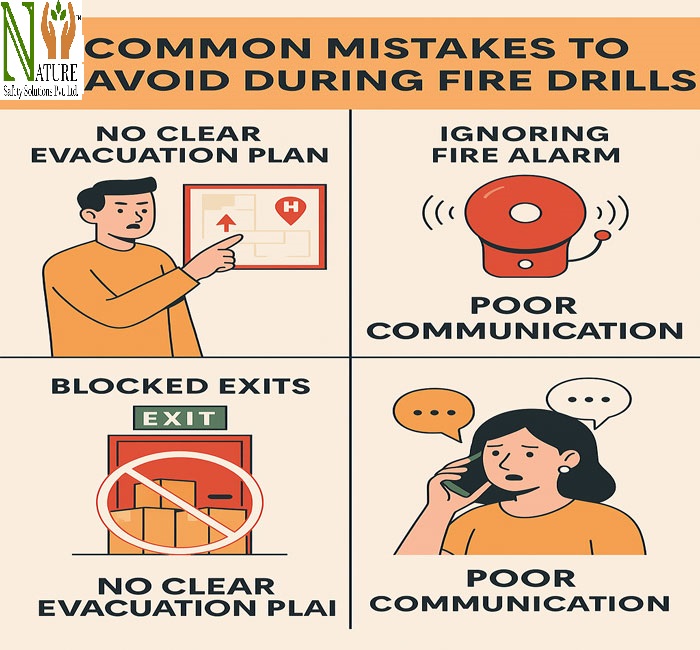Fire drills are a key part of any workplace safety plan. They help prepare employees for emergencies, ensure safe evacuations, and identify any problems in emergency procedures.
However, not all fire drills are effective. In many cases, simple but serious mistakes can reduce their usefulness. This article explores the most common mistakes made during fire drills and how to avoid them. Lets start:

Not Treating the Drill Seriously
One major issue is when employees do not take the drill seriously. Some people treat it as a break from work. Others do not follow instructions properly. This attitude can create chaos during an actual fire.
To fix this, employers must explain the importance of fire drills. Everyone should know that it could save lives. Managers should lead by example and treat every drill with full attention.
No Clear Evacuation Plan
A fire drill is only useful if there is a clear and well-communicated plan. If employees do not know where to go or which exit to use, confusion can follow. This slows down evacuation. Each building must have a detailed map of evacuation routes.
These routes should be displayed at common locations such as entrances, break rooms, and notice boards. Primary and secondary exits should be marked. Make sure that new hires are trained in the evacuation procedure as part of their onboarding.
Not Assigning Specific Roles
When a fire alarm rings, everyone must know what to do. Assigning roles in advance can prevent confusion. Designate fire wardens to guide employees. Assign helpers for people with mobility issues. Identify someone to check restrooms or other hidden spaces. These people should receive proper training and be ready to act. Without clear roles, people may wait for someone else to lead, wasting valuable time.
Overlooking Employees with Special Needs
Some people may need help evacuating quickly. This includes those with disabilities, injuries, or even temporary health conditions. If your fire drill does not account for them, it is incomplete.
Plan in advance how to assist these individuals. Appoint someone to support them. Use wheelchairs or evacuation chairs if necessary. Make sure that all employees, regardless of physical condition, can get to safety.
Poor Communication
Clear communication is vital for a successful drill. If the drill is scheduled, inform employees in advance. Use emails, bulletin boards, and announcements to spread the word.
For surprise drills, make sure alarms and instructions are clear and loud enough to be heard everywhere. Confusion during a drill can lead to panic. Good communication reduces this risk.
Failing to Account for Everyone
In an actual emergency, knowing who is safely outside is critical. Fire drills should include a system to check attendance. Use sign-in and sign-out sheets or digital systems to track employees. Team leaders can perform roll calls at the assembly point. This ensures that no one is left behind or missing.
Ignoring Feedback and Review
After each drill, collect feedback from participants. What worked well? What needs improvement? Hold a short debriefing session. This helps you refine the evacuation plan. Encourage employees to speak openly about any issues they faced. Use their feedback to make the next drill more effective.
Choosing the Wrong Assembly Area
A poorly located assembly point can be dangerous. It should be far from buildings, roads, and fire zones. The area must be large enough for everyone.
It should also be easy to find. Mark the assembly area clearly with signs. Do not choose a location that blocks emergency responders or puts employees at risk.
Lack of Practice
One drill per year is not enough. Practice should happen regularly. Repeat drills help employees remember the plan. They also test different scenarios, such as blocked exits or power outages. Surprise drills can be useful but must be safe. Regular practice builds confidence and readiness.
Not Updating the Plan
Workplaces change over time. New equipment, construction, or staffing changes can affect evacuation routes. Your fire drill plan must be reviewed often. Update maps, exit signs, and employee lists. Include any new procedures in the next drill. Keep the plan fresh and accurate.
No Coordination with Emergency Services
Involving local fire departments or emergency services adds realism. They can offer suggestions to improve your drill. They may also spot risks you missed.
Some companies skip this step, missing valuable expert advice. Building a relationship with local responders ensures better support in a real emergency.
Relying Only on One Drill Format
Drills should not be predictable. If every drill follows the same script, employees may lose focus. Change the time, location, or scenario of each drill. Practice evacuations during different shifts. Include scenarios like blocked doors or smoke-filled hallways. This helps employees learn to adapt.
Failing to Educate New Employees
New hires should not wait for the next drill to learn safety steps. Fire evacuation training must be part of employee orientation. Show them the routes, exits, and assembly points. Explain their role in an emergency. Ignoring this step puts them and others at risk.
Also read:-
